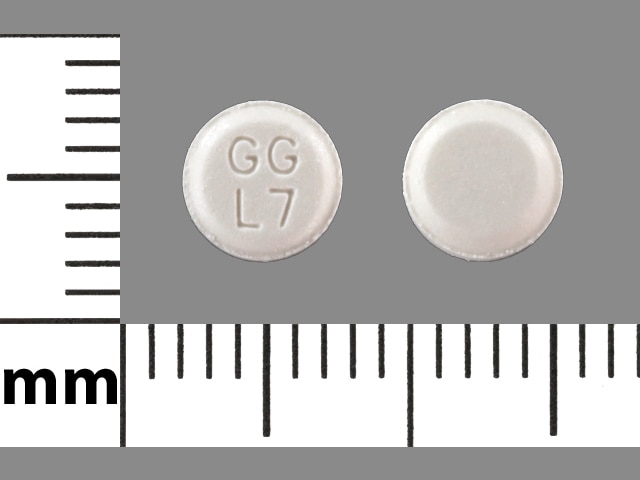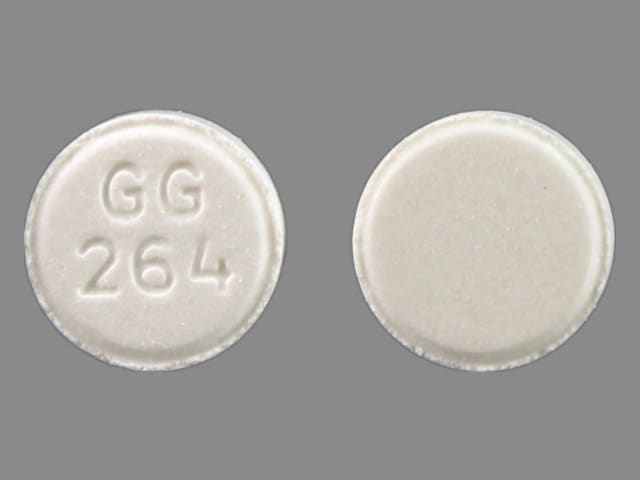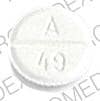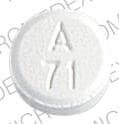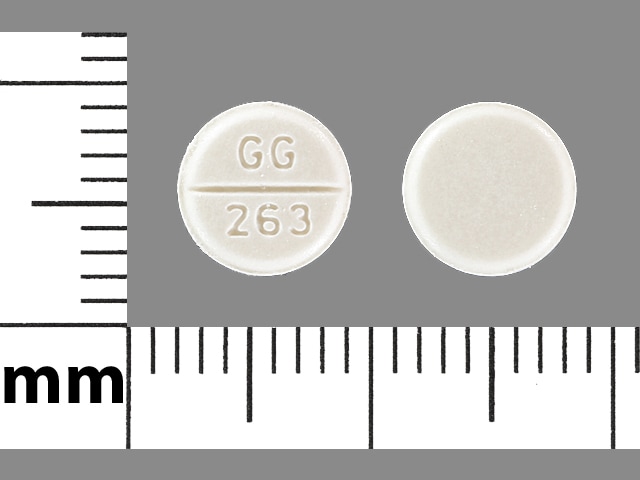Boxed Warning
Cessation of therapy:
Advise patients with coronary artery disease who are being treated with atenolol against abrupt discontinuation of therapy. Severe exacerbation of angina and the occurrence of myocardial infarction (MI) and ventricular arrhythmias have been reported in patients with angina following the abrupt discontinuation of therapy with beta-blockers. The last 2 complications may occur with or without preceding exacerbation of the angina pectoris. As with other beta-blockers, when discontinuation of atenolol is planned, observe the patient carefully and advise the patient to limit physical activity to a minimum. If the angina worsens or acute coronary insufficiency develops, it is recommended that atenolol be promptly reinstituted, at least temporarily. Because coronary artery disease is common and may be unrecognized, it may be prudent not to discontinue atenolol therapy abruptly, even in patients treated only for hypertension.
Dosage Forms
Excipient information presented when available (limited, particularly for generics); consult specific product labeling.
Tablet, Oral:
Tenormin: 25 mg, 50 mg, 100 mg
Generic: 25 mg, 50 mg, 100 mg
Pharmacology
Mechanism of Action
Competitively blocks response to beta-adrenergic stimulation, selectively blocks beta1-receptors with little or no effect on beta2-receptors except at high doses
Pharmacokinetics/Pharmacodynamics
Absorption
Oral: Rapid, incomplete (~50%)
Distribution
Low lipophilicity; does not cross blood-brain barrier
Metabolism
Limited hepatic
Excretion
Feces (50%); urine (40% as unchanged drug)
Onset of Action
Oral: ≤1 hour; Peak effect: Oral: 2 to 4 hours
Time to Peak
Plasma: Oral: 2 to 4 hours
Duration of Action
Normal renal function: Beta-blocking effect: 12 to 24 hours; Antihypertensive effect: Oral: 24 hours
Half-Life Elimination
Beta:
Newborns (<24 hours of age) born to mothers receiving atenolol: Mean: 16 hours; up to 35 hours (Rubin 1983)
Children and Adolescents 5 to 16 years of age: Mean: 4.6 hours; range: 3.5 to 7 hours; Patients >10 years of age may have longer half-life (>5 hours) compared to children 5 to 10 years of age (<5 hours) (Buck 1989)
Adults: Normal renal function: 6 to 7 hours, prolonged with renal impairment; End-stage renal disease (ESRD): 15 to 35 hours
Protein Binding
6% to 16%
Use in Specific Populations
Special Populations: Renal Function Impairment
Elimination is closely related to GFR. Significant accumulation occurs when CrCl falls below 35 mL/minute/1.73 m2.
Special Populations: Elderly
Total clearance is about 50% lower than in younger subjects. Half-life is markedly longer in elderly patients.
Use: Labeled Indications
Acute MI: Management of hemodynamically stable patients with definite or suspected acute MI to reduce cardiovascular mortality.
Guideline recommendations: According to the American College of Cardiology Foundation/American Heart Association (ACC/AHA) guidelines for the management of ST-elevation myocardial infarction (STEMI) and the ACC/AHA guidelines for the management of non-ST-elevation ACS (NSTE-ACS), oral beta-blockers should be initiated within the first 24 hours unless the patient has signs of heart failure, evidence of a low-output state, an increased risk for cardiogenic shock, or other contraindications. However, recommendations do not specify any particular beta-blocking agent for optimal treatment of NSTE-ACS. Thus, clinicians must use practical experience to determine proper therapy in managing patients (ACC/AHA [Amsterdam 2014]; ACC/AHA [O'Gara 2013]).
Angina pectoris caused by coronary atherosclerosis: Long-term management of patients with angina pectoris.
Hypertension: Management of hypertension. Note: Beta-blockers are not recommended as first-line therapy (ACC/AHA [Whelton 2017]).
Use: Off Label
Atrial fibrillation (rate control)yes
Based on the 2014 American Heart Association/American College of Cardiology/Heart Rhythm Society (AHA/ACC/HRS) guideline for the management of patients with atrial fibrillation (AF), the use of beta-blockers, including atenolol, for ventricular rate control in patients with paroxysmal, persistent, or permanent AF is effective and recommended for this condition.
Supraventricular tachycardia (AV nodal reentrant tachycardia [AVNRT], AV reentrant tachycardia [AVRT], atrial flutter, focal atrial tachycardia [AT])yes
Based on the American College of Cardiology/American Heart Association/Heart Rhythm Society guidelines for the management of patients with supraventricular arrhythmias, the use of an oral beta-blocker, including atenolol, is an effective and recommended treatment option for the ongoing management of a variety of symptomatic supraventricular tachycardias (AVNRT, AVRT, focal AT) without pre-excitation in patients who are not candidates for, or prefer not to undergo catheter ablation. Oral beta-blockers, including atenolol, may also be useful for the ongoing management (acute rate control) in hemodynamically stable patients with atrial flutter.
Thyrotoxicosisyes
Based on the 2016 American Thyroid Association guidelines for diagnosis and management of hyperthyroidism and other causes of thyrotoxicosis, beta-blockers, including atenolol, are effective and recommended in the treatment of symptomatic thyrotoxicosis. Beta-blockers should also be considered in asymptomatic patients who are at increased risk of complications due to worsening hyperthyroidism Ross 2016.
Ventricular arrhythmiascyes
In patients with arrhythmogenic right ventricular cardiomyopathy (ARVC), data from observational studies suggest that atenolol may be beneficial at reducing ventricular arrhythmias Marcus 2009. The American Heart Association/American College of Cardiology/Heart Rhythm Society (AHA/ACC/HRS) guideline for management of patients with ventricular arrhythmias and prevention of sudden cardiac death recommends beta-blocker therapy in patients with ARVC and history of ventricular arrhythmia and suggests that beta-blockers may be considered in patients without a history of ventricular arrhythmia.
In patients with congenital long QT syndrome, data from observational studies suggest that beta-blockers may be beneficial at reducing the risk of cardiac events, including ventricular arrhythmias, especially in patients with long QT syndrome type 1 or type 2 Chockalingam 2012, Goldenberg 2010, Moss 2000, Sauer 2007. Atenolol, nadolol, and propranolol may be preferred choices for patients with long QT syndrome based on the currently available data and American Heart Association/American College of Cardiology/Heart Rhythm Society (AHA/ACC/HRS) guideline for management of patients with ventricular arrhythmias and prevention of sudden cardiac death ACC/AHA/HRS [Al-Khatib 2017].
Based on the American Heart Association/American College of Cardiology/Heart Rhythm Society (AHA/ACC/HRS) guideline for management of patients with ventricular arrhythmias and prevention of sudden cardiac death, beta-blockers are effective for control of ventricular arrhythmias and ventricular premature beats.
Contraindications
Hypersensitivity to atenolol or any component of the formulation; sinus bradycardia; heart block greater than first-degree (except in patients with a functioning artificial pacemaker); cardiogenic shock; uncompensated cardiac failure
Documentation of allergenic cross-reactivity for beta-blockers is limited. However, because of similarities in chemical structure and/or pharmacologic actions, the possibility of cross-sensitivity cannot be ruled out with certainty.
Canadian labeling: Additional contraindications (not in US labeling): Bradycardia (regardless of origin); cor pulmonale; hypotension; severe peripheral arterial disorders; anesthesia with agents that produce myocardial depression; Pheochromocytoma (in the absence of alpha-blockade); metabolic acidosis
Dosage and Administration
Dosing: Adult
Angina pectoris: Oral: Initial: 50 mg once daily; may increase to 100 mg once daily. Some patients may require 200 mg once daily.
Atrial fibrillation (rate control) (off-label use): Usual maintenance dose: 25 to 100 mg once daily (AHA/ACC/HRS [January 2014])
Hypertension (alternative agent): Oral: Initial: 50 mg once daily; titrate as needed based on patient response every 1 to 2 weeks up to 100 mg once daily. Doses >100 mg are unlikely to produce any further benefit.
MI (ST elevation MI or NSTE-ACS): Oral: Initial: 50 to 100 mg in 1 or 2 divided doses with titration to desired effect. In general, oral beta-blockers should be initiated within the first 24 hours post myocardial infarction and continued indefinitely for most patients (ISIS-1 1986; ACC/AHA [Amsterdam 2014]; ACCF/AHA [O'Gara 2013]).
Supraventricular tachycardia (off-label use): Oral: Initial: 25 to 50 mg daily; maximum maintenance dose: 100 mg/day (ACC/AHA/HRS [Page 2015])
Thyrotoxicosis (off-label use): Oral: 25 to 100 mg once or twice daily (Ross 2016)
Ventricular arrhythmias (off-label use): Oral: 25 to 100 mg/day (AHA/ACC/HRS [Al-Khatib 2017]; Krittatphong 2002)
Dosing: Geriatric
Refer to adult dosing. In the management of hypertension, consider lower initial doses and titrate to response (Aronow 2011).
Dosing: Pediatric
Note: Dosage should be individualized based on patient response.
Arrhythmias: Limited data available: Infants, Children, and Adolescents: Oral:
Long QT syndrome: Usual range: 0.5 to 1 mg/kg/day either once daily or in divided doses every 12 hours (Kliegman, 2011). In a retrospective trial (n=57; mean age: 9 ± 6 years) that titrated atenolol to achieve a maximum heart rate less than 150 bpm (Holter monitor and exercise treadmill), higher doses were reported; mean effective dose: 1.4 ± 0.5 mg/kg/day in 2 divided doses (Moltedo, 2011)
Supraventricular tachycardia: Usual range: 0.3 to 1 mg/kg/day either once daily or in divided doses every 12 hours (Kliegman, 2011, Mehta, 1996; Trippel, 1989). In two separate trials, titration of the dose to >1.4 mg/kg/day did not show additional treatment successes and potentially increased the risk of adverse effects (Mehta, 1996; Trippel, 1989).
Hemangioma, infantile: Limited data available: Infants and Children <2 years: Oral: 1 mg/kg/dose once daily for 6 months; dosing based on a randomized, controlled noninferiority trial compared to propranolol (n=23 total, atenolol treatment group: n=13); atenolol was found to be as effective as propranolol; no significant adverse effects were reported in either group (Abarzua-Araya, 2014)
Hypertension: Children and Adolescents: Oral: Initial: 0.5 to 1 mg/kg/day either once daily or divided in doses twice daily; titrate dose to effect; usual range: 0.5 to 1.5 mg/kg/day; maximum daily dose: 2 mg/kg/day not to exceed 100 mg/day (NHBPEP, 2004; NLHBI, 2011)
Thyrotoxicosis: Limited data available: Children and Adolescents: Oral: 1 to 2 mg/kg once daily; may increase to twice daily if needed; maximum dose: 100 mg/dose (Bahn 2011; Kliegman 2011)
Extemporaneously Prepared
2 mg/mL Oral Suspension (ASHP Standard Concentration) (ASHP 2017)
A 2 mg/mL oral suspension may be made with tablets. Crush four 50 mg tablets in a mortar and reduce to a fine powder. Add a small amount of glycerin and mix to a uniform paste. Mix while adding Ora-Sweet SF vehicle in incremental proportions to almost 100 mL; transfer to a calibrated amber bottle, rinse mortar with vehicle, and add quantity of vehicle sufficient to make 100 mL. Label “shake well”. Stable for 90 days at room temperature.
Nahata MC and Pai VB. Pediatric Drug Formulations. 6th ed. Cincinnati, OH: Harvey Whitney Books Co; 2014.Patel D, Doshi DH, Desai A. Short-term stability of atenolol in oral liquid formulations. Int J Pharm Compd. 1997;1(6):437-439.23989440
Administration
Oral: May be administered without regard to meals.
Storage
Store at 20°C to 25°C (68°F to 77°F).
Atenolol Images
Drug Interactions
Acetylcholinesterase Inhibitors: May enhance the bradycardic effect of Beta-Blockers. Monitor therapy
Alfuzosin: May enhance the hypotensive effect of Blood Pressure Lowering Agents. Monitor therapy
Alpha1-Blockers: Beta-Blockers may enhance the orthostatic hypotensive effect of Alpha1-Blockers. The risk associated with ophthalmic products is probably less than systemic products. Monitor therapy
Alpha2-Agonists: May enhance the AV-blocking effect of Beta-Blockers. Sinus node dysfunction may also be enhanced. Beta-Blockers may enhance the rebound hypertensive effect of Alpha2-Agonists. This effect can occur when the Alpha2-Agonist is abruptly withdrawn. Management: Closely monitor heart rate during treatment with a beta blocker and clonidine. Withdraw beta blockers several days before clonidine withdrawal when possible, and monitor blood pressure closely. Recommendations for other alpha2-agonists are unavailable. Exceptions: Apraclonidine. Consider therapy modification
Amifostine: Blood Pressure Lowering Agents may enhance the hypotensive effect of Amifostine. Management: When amifostine is used at chemotherapy doses, blood pressure lowering medications should be withheld for 24 hours prior to amifostine administration. If blood pressure lowering therapy cannot be withheld, amifostine should not be administered. Consider therapy modification
Amiodarone: May enhance the bradycardic effect of Beta-Blockers. Possibly to the point of cardiac arrest. Amiodarone may increase the serum concentration of Beta-Blockers. Monitor therapy
Amphetamines: May diminish the antihypertensive effect of Antihypertensive Agents. Monitor therapy
Ampicillin: May decrease the bioavailability of Atenolol. Monitor therapy
Antipsychotic Agents (Second Generation [Atypical]): Blood Pressure Lowering Agents may enhance the hypotensive effect of Antipsychotic Agents (Second Generation [Atypical]). Monitor therapy
Bacampicillin: May decrease the bioavailability of Atenolol. Monitor therapy
Barbiturates: May enhance the hypotensive effect of Blood Pressure Lowering Agents. Monitor therapy
Benperidol: May enhance the hypotensive effect of Blood Pressure Lowering Agents. Monitor therapy
Beta2-Agonists: Beta-Blockers (Beta1 Selective) may diminish the bronchodilatory effect of Beta2-Agonists. Of particular concern with nonselective beta-blockers or higher doses of the beta1 selective beta-blockers. Monitor therapy
Bradycardia-Causing Agents: May enhance the bradycardic effect of other Bradycardia-Causing Agents. Monitor therapy
Brigatinib: May diminish the antihypertensive effect of Antihypertensive Agents. Brigatinib may enhance the bradycardic effect of Antihypertensive Agents. Monitor therapy
Brimonidine (Topical): May enhance the hypotensive effect of Blood Pressure Lowering Agents. Monitor therapy
Bromperidol: Blood Pressure Lowering Agents may enhance the hypotensive effect of Bromperidol. Bromperidol may diminish the hypotensive effect of Blood Pressure Lowering Agents. Avoid combination
Bupivacaine: Beta-Blockers may increase the serum concentration of Bupivacaine. Monitor therapy
Calcium Channel Blockers (Nondihydropyridine): May enhance the hypotensive effect of Beta-Blockers. Bradycardia and signs of heart failure have also been reported. Calcium Channel Blockers (Nondihydropyridine) may increase the serum concentration of Beta-Blockers. Exceptions: Bepridil. Monitor therapy
Cardiac Glycosides: Beta-Blockers may enhance the bradycardic effect of Cardiac Glycosides. Monitor therapy
Ceritinib: Bradycardia-Causing Agents may enhance the bradycardic effect of Ceritinib. Management: If this combination cannot be avoided, monitor patients for evidence of symptomatic bradycardia, and closely monitor blood pressure and heart rate during therapy. Exceptions are discussed in separate monographs. Consider therapy modification
Cholinergic Agonists: Beta-Blockers may enhance the adverse/toxic effect of Cholinergic Agonists. Of particular concern are the potential for cardiac conduction abnormalities and bronchoconstriction. Monitor therapy
Dexmethylphenidate: May diminish the therapeutic effect of Antihypertensive Agents. Monitor therapy
Diazoxide: May enhance the hypotensive effect of Blood Pressure Lowering Agents. Monitor therapy
Dipyridamole: May enhance the bradycardic effect of Beta-Blockers. Monitor therapy
Disopyramide: May enhance the bradycardic effect of Beta-Blockers. Beta-Blockers may enhance the negative inotropic effect of Disopyramide. Monitor therapy
Dronedarone: May enhance the bradycardic effect of Beta-Blockers. Dronedarone may increase the serum concentration of Beta-Blockers. This likely applies only to those agents that are metabolized by CYP2D6. Management: Use lower initial beta-blocker doses; adequate tolerance of the combination, based on ECG findings, should be confirmed prior to any increase in beta-blocker dose. Consider therapy modification
DULoxetine: Blood Pressure Lowering Agents may enhance the hypotensive effect of DULoxetine. Monitor therapy
EPINEPHrine (Nasal): Beta-Blockers (Beta1 Selective) may diminish the therapeutic effect of EPINEPHrine (Nasal). Monitor therapy
EPINEPHrine (Oral Inhalation): Beta-Blockers (Beta1 Selective) may diminish the therapeutic effect of EPINEPHrine (Oral Inhalation). Monitor therapy
Epinephrine (Racemic): Beta-Blockers (Beta1 Selective) may diminish the therapeutic effect of Epinephrine (Racemic). Monitor therapy
EPINEPHrine (Systemic): Beta-Blockers (Beta1 Selective) may diminish the therapeutic effect of EPINEPHrine (Systemic). Monitor therapy
Ergot Derivatives: Beta-Blockers may enhance the vasoconstricting effect of Ergot Derivatives. Exceptions: Nicergoline. Consider therapy modification
Fexinidazole [INT]: Bradycardia-Causing Agents may enhance the arrhythmogenic effect of Fexinidazole [INT]. Avoid combination
Fingolimod: Beta-Blockers may enhance the bradycardic effect of Fingolimod. Management: Avoid the concomitant use of fingolimod and beta-blockers if possible. If coadministration is necessary, patients should have overnight continuous ECG monitoring conducted after the first dose of fingolimod. Monitor patients for bradycardia. Consider therapy modification
Floctafenine: May enhance the adverse/toxic effect of Beta-Blockers. Avoid combination
Glycopyrrolate (Systemic): May increase the serum concentration of Atenolol. Monitor therapy
Grass Pollen Allergen Extract (5 Grass Extract): Beta-Blockers may enhance the adverse/toxic effect of Grass Pollen Allergen Extract (5 Grass Extract). More specifically, Beta-Blockers may inhibit the ability to effectively treat severe allergic reactions to Grass Pollen Allergen Extract (5 Grass Extract) with epinephrine. Some other effects of epinephrine may be unaffected or even enhanced (e.g., vasoconstriction) during treatment with Beta-Blockers. Consider therapy modification
Herbs (Hypertensive Properties): May diminish the antihypertensive effect of Antihypertensive Agents. Monitor therapy
Herbs (Hypotensive Properties): May enhance the hypotensive effect of Blood Pressure Lowering Agents. Monitor therapy
Hypotension-Associated Agents: Blood Pressure Lowering Agents may enhance the hypotensive effect of Hypotension-Associated Agents. Monitor therapy
Insulins: Beta-Blockers may enhance the hypoglycemic effect of Insulins. Monitor therapy
Ivabradine: Bradycardia-Causing Agents may enhance the bradycardic effect of Ivabradine. Monitor therapy
Lacosamide: Bradycardia-Causing Agents may enhance the AV-blocking effect of Lacosamide. Monitor therapy
Levodopa-Containing Products: Blood Pressure Lowering Agents may enhance the hypotensive effect of Levodopa-Containing Products. Monitor therapy
Lidocaine (Systemic): Beta-Blockers may increase the serum concentration of Lidocaine (Systemic). Monitor therapy
Lidocaine (Topical): Beta-Blockers may increase the serum concentration of Lidocaine (Topical). Monitor therapy
Lormetazepam: May enhance the hypotensive effect of Blood Pressure Lowering Agents. Monitor therapy
Mepivacaine: Beta-Blockers may increase the serum concentration of Mepivacaine. Monitor therapy
Methacholine: Beta-Blockers may enhance the adverse/toxic effect of Methacholine. Monitor therapy
Methoxyflurane: May enhance the hypotensive effect of Beta-Blockers. Monitor therapy
Methylphenidate: May diminish the antihypertensive effect of Antihypertensive Agents. Monitor therapy
Midodrine: May enhance the bradycardic effect of Bradycardia-Causing Agents. Monitor therapy
Molsidomine: May enhance the hypotensive effect of Blood Pressure Lowering Agents. Monitor therapy
Naftopidil: May enhance the hypotensive effect of Blood Pressure Lowering Agents. Monitor therapy
Nicergoline: May enhance the hypotensive effect of Blood Pressure Lowering Agents. Monitor therapy
Nicorandil: May enhance the hypotensive effect of Blood Pressure Lowering Agents. Monitor therapy
NIFEdipine: May enhance the hypotensive effect of Beta-Blockers. NIFEdipine may enhance the negative inotropic effect of Beta-Blockers. Monitor therapy
Nitroprusside: Blood Pressure Lowering Agents may enhance the hypotensive effect of Nitroprusside. Monitor therapy
Nonsteroidal Anti-Inflammatory Agents: May diminish the antihypertensive effect of Beta-Blockers. Monitor therapy
Obinutuzumab: May enhance the hypotensive effect of Blood Pressure Lowering Agents. Management: Consider temporarily withholding blood pressure lowering medications beginning 12 hours prior to obinutuzumab infusion and continuing until 1 hour after the end of the infusion. Consider therapy modification
Opioids (Anilidopiperidine): May enhance the bradycardic effect of Beta-Blockers. Opioids (Anilidopiperidine) may enhance the hypotensive effect of Beta-Blockers. Monitor therapy
Pentoxifylline: May enhance the hypotensive effect of Blood Pressure Lowering Agents. Monitor therapy
Pholcodine: Blood Pressure Lowering Agents may enhance the hypotensive effect of Pholcodine. Monitor therapy
Phosphodiesterase 5 Inhibitors: May enhance the hypotensive effect of Blood Pressure Lowering Agents. Monitor therapy
Prostacyclin Analogues: May enhance the hypotensive effect of Blood Pressure Lowering Agents. Monitor therapy
Quinagolide: May enhance the hypotensive effect of Blood Pressure Lowering Agents. Monitor therapy
Regorafenib: May enhance the bradycardic effect of Beta-Blockers. Monitor therapy
Reserpine: May enhance the hypotensive effect of Beta-Blockers. Monitor therapy
Rivastigmine: May enhance the bradycardic effect of Beta-Blockers. Avoid combination
Ruxolitinib: May enhance the bradycardic effect of Bradycardia-Causing Agents. Management: Ruxolitinib Canadian product labeling recommends avoiding use with bradycardia-causing agents to the extent possible. Monitor therapy
Siponimod: Bradycardia-Causing Agents may enhance the bradycardic effect of Siponimod. Management: Avoid coadministration of siponimod with drugs that may cause bradycardia. Consider therapy modification
Sulfonylureas: Beta-Blockers may enhance the hypoglycemic effect of Sulfonylureas. Cardioselective beta-blockers (eg, acebutolol, atenolol, metoprolol, and penbutolol) may be safer than nonselective beta-blockers. All beta-blockers appear to mask tachycardia as an initial symptom of hypoglycemia. Ophthalmic beta-blockers are probably associated with lower risk than systemic agents. Monitor therapy
Terlipressin: May enhance the bradycardic effect of Bradycardia-Causing Agents. Monitor therapy
Theophylline Derivatives: Beta-Blockers (Beta1 Selective) may diminish the bronchodilatory effect of Theophylline Derivatives. Management: Monitor for reduced theophylline efficacy during concomitant use with any beta-blocker. Beta-1 selective agents are less likely to antagonize theophylline than nonselective agents, but selectivity may be lost at higher doses. Monitor therapy
Tofacitinib: May enhance the bradycardic effect of Bradycardia-Causing Agents. Monitor therapy
Yohimbine: May diminish the antihypertensive effect of Antihypertensive Agents. Monitor therapy
Test Interactions
Increased glucose; decreased HDL; may lead to false-positive aldosterone/renin ratio (ARR) (Funder 2016)
Adverse Reactions
Incidence rates are from studies in hypertensive patients unless otherwise noted.
>10%:
Cardiovascular: Hypotension (acute myocardial infarction: 25%), cardiac failure (acute myocardial infarction: 19%), bradycardia (acute myocardial infarction: 18%; 3%), ventricular tachycardia (acute myocardial infarction: 16%), cold extremities (12%), supraventricular tachycardia (acute myocardial infarction: 12%)
Central nervous system: Fatigue (≤26%), dizziness (1% to 13%), depression (≤12%)
1% to 10%:
Cardiovascular: Bundle branch block (acute myocardial infarction: 7%), atrial fibrillation (acute myocardial infarction: 5%), heart block (acute myocardial infarction: 5%), atrial flutter (acute myocardial infarction: 2%), orthostatic hypotension (2%), pulmonary embolism (acute myocardial infarction: 1%)
Central nervous system: Abnormal dreams (3%), lethargy (1% to 3%), vertigo (2%), drowsiness (≤2%)
Gastrointestinal: Nausea (3% to 4%), diarrhea (2% to 3%)
Neuromuscular & skeletal: Limb pain (3%)
Respiratory: Bronchospasm (acute myocardial infarction: 1%)
<1%, postmarketing, and/or case reports: Antibody development, cardiogenic shock, exacerbation of psoriasis, hallucination, headache, impotence, increased liver enzymes, increased serum bilirubin, lupus-like syndrome, nonthrombocytopenic purpura, Peyronie disease, psoriasiform eruption, psychosis, Raynaud disease, renal failure syndrome, sick sinus syndrome, thrombocytopenia, transient alopecia, visual disturbance, xerostomia
Warnings/Precautions
Concerns related to adverse events:
- Anaphylactic reactions: Use caution with history of severe anaphylaxis to allergens; patients taking beta-blockers may become more sensitive to repeated challenges. Treatment of anaphylaxis (eg, epinephrine) in patients taking beta-blockers may be ineffective or promote undesirable effects.
Disease-related concerns:
- Bronchospastic disease: In general, patients with bronchospastic disease should not receive beta-blockers; however, atenolol, with B1 selectivity, has been used cautiously with close monitoring.
- Conduction abnormality: Consider preexisting conditions such as sick sinus syndrome before initiating.
- Diabetes: Use with caution in patients with diabetes mellitus; may potentiate hypoglycemia and/or mask signs and symptoms.
- Heart failure (HF): Use with caution in patients with compensated heart failure and monitor for a worsening of the condition (efficacy of atenolol in HF has not been demonstrated).
- Myasthenia gravis: Use with caution in patients with myasthenia gravis.
- Peripheral vascular disease (PVD) and Raynaud disease: May precipitate or aggravate symptoms of arterial insufficiency in patients with PVD and Raynaud disease. Use with caution and monitor for progression of arterial obstruction.
- Pheochromocytoma (untreated): Adequate alpha-blockade is required prior to use of any beta-blocker.
- Prinzmetal variant angina: Beta-blockers without alpha1-adrenergic receptor blocking activity should be avoided in patients with Prinzmetal variant angina since unopposed alpha1-adrenergic receptors mediate coronary vasoconstriction and can worsen anginal symptoms (Mayer 1998).
- Psoriasis: Beta-blocker use has been associated with induction or exacerbation of psoriasis, but cause and effect have not been firmly established.
- Renal impairment: Use with caution in patients with renal impairment; dosage adjustment required.
- Thyroid disease: May mask signs of hyperthyroidism (eg, tachycardia). If hyperthyroidism is suspected, carefully manage and monitor; abrupt withdrawal may precipitate thyroid storm. Alterations in thyroid function tests may be observed.
Concurrent drug therapy issues:
- Drug-drug interactions: Potentially significant interactions may exist, requiring dose or frequency adjustment, additional monitoring, and/or selection of alternative therapy. Consult drug interactions database for more detailed information.
Special populations:
- Elderly: Bradycardia may be observed more frequently in elderly patients (>65 years of age); dosage reductions may be necessary.
Other warnings/precautions:
- Abrupt withdrawal: [US Boxed Warning]: Beta-blocker therapy should not be withdrawn abruptly (particularly in patients with CAD), but gradually tapered to avoid acute tachycardia, hypertension, and/or ischemia. Severe exacerbation of angina, ventricular arrhythmias, and myocardial infarction (MI) have been reported following abrupt withdrawal of beta-blocker therapy. Temporary but prompt resumption of beta-blocker therapy may be indicated with worsening of angina or acute coronary insufficiency.
- Major surgery: Chronic beta-blocker therapy should not be routinely withdrawn prior to major surgery.
Monitoring Parameters
Acute cardiac treatment: Monitor ECG and blood pressure.
Hypertension: Blood pressure, heart rate, serum glucose regularly (in patients with diabetes)
The 2017 Guideline for the Prevention, Detection, Evaluation, and Management of High Blood Pressure in Adults (ACC/AHA [Whelton 2017]):
Confirmed hypertension and known CVD or 10-year ASCVD risk ≥10%: Target blood pressure <130/80 mm Hg is recommended.
Confirmed hypertension without markers of increased ASCVD risk: Target blood pressure <130/80 mm Hg may be reasonable.
Pregnancy
Pregnancy Risk Factor
D
Pregnancy Considerations
Atenolol crosses the placenta and is found in cord blood.
Maternal use of atenolol may cause harm to the fetus. Adverse events, such as bradycardia, hypoglycemia and reduced birth weight, have been observed following in utero exposure to atenolol. If maternal use of a beta-blocker is needed, fetal growth should be monitored during pregnancy and the newborn should be monitored for 48 hours after delivery for bradycardia, hypoglycemia, and respiratory depression (ESC [Regitz-Zagrosek 2018]).
Chronic maternal hypertension is also associated with adverse events in the fetus/infant. Chronic maternal hypertension may increase the risk of birth defects, low birth weight, premature delivery, stillbirth, and neonatal death. Actual fetal/neonatal risks may be related to duration and severity of maternal hypertension. Untreated chronic hypertension may also increase the risks of adverse maternal outcomes, including gestational diabetes, preeclampsia, delivery complications, stroke, and myocardial infarction (ACOG 203 2019).
The maternal pharmacokinetic parameters of atenolol during the second and third trimesters are within the ranges reported in nonpregnant patients (Hebert 2005). When treatment of chronic hypertension in pregnancy is indicated, atenolol is not recommended due to adverse fetal/neonatal events (ACOG 203 2019; ESC [Regitz-Zagrosek 2018]; Magee 2014). If atenolol is used in women with preexisting hypertension, it should be discontinued as soon as pregnancy is diagnosed (Magee 2014). Atenolol is also not recommended for the treatment of atrial fibrillation or supraventricular tachycardia during pregnancy; consult current guidelines for specific recommendations (ESC [Regitz-Zagrosek 2018]).
Patient Education
What is this drug used for?
- It is used to treat high blood pressure.
- It is used to treat a type of long-term chest pain (stable angina) in some people.
- It is used after a heart attack to lower the chance of death.
- It may be given to you for other reasons. Talk with the doctor.
Frequently reported side effects of this drug
- Loss of strength and energy
Other side effects of this drug: Talk with your doctor right away if you have any of these signs of:
- Chest pain
- Severe dizziness
- Passing out
- Sensation of cold
- Depression
- Shortness of breath
- Excessive weight gain
- Swelling of arm or leg
- Slow heartbeat
- Signs of a significant reaction like wheezing; chest tightness; fever; itching; bad cough; blue skin color; seizures; or swelling of face, lips, tongue, or throat.
Note: This is not a comprehensive list of all side effects. Talk to your doctor if you have questions.
Consumer Information Use and Disclaimer: This information should not be used to decide whether or not to take this medicine or any other medicine. Only the healthcare provider has the knowledge and training to decide which medicines are right for a specific patient. This information does not endorse any medicine as safe, effective, or approved for treating any patient or health condition. This is only a brief summary of general information about this medicine. It does NOT include all information about the possible uses, directions, warnings, precautions, interactions, adverse effects, or risks that may apply to this medicine. This information is not specific medical advice and does not replace information you receive from the healthcare provider. You must talk with the healthcare provider for complete information about the risks and benefits of using this medicine.
